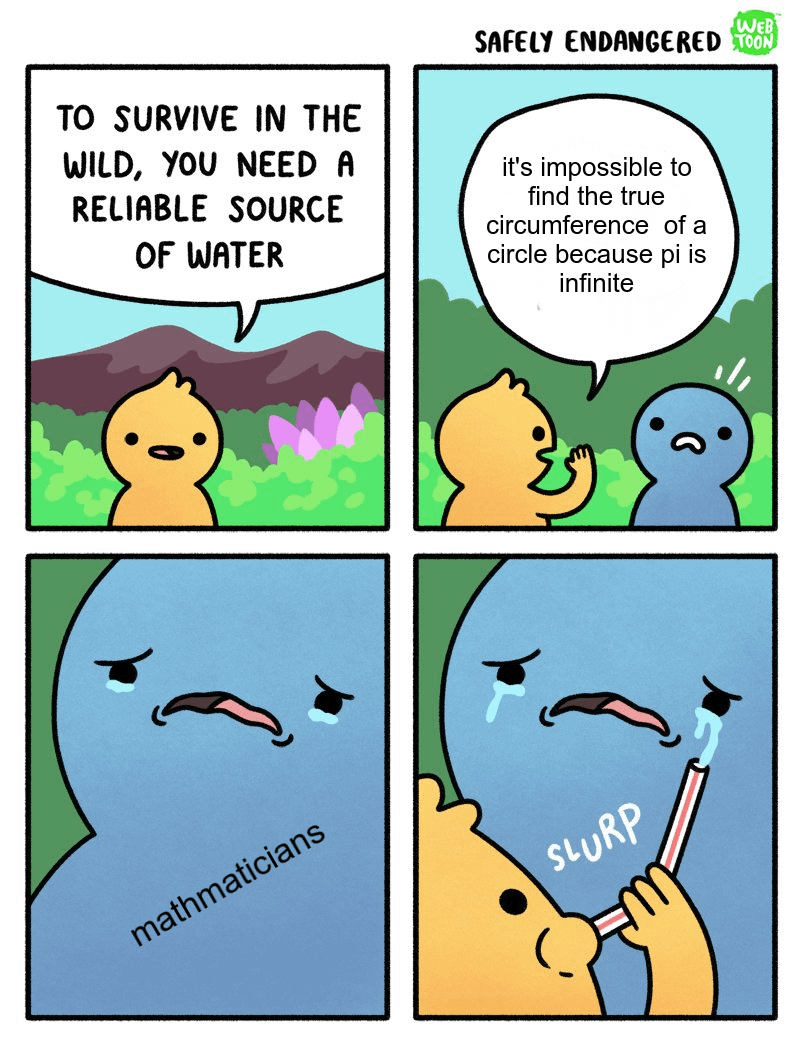Not true. If you define the circumference in terms of pi, you can define the circumference exactly.
Science Memes
Welcome to c/science_memes @ Mander.xyz!
A place for majestic STEMLORD peacocking, as well as memes about the realities of working in a lab.

Rules
- Don't throw mud. Behave like an intellectual and remember the human.
- Keep it rooted (on topic).
- No spam.
- Infographics welcome, get schooled.
This is a science community. We use the Dawkins definition of meme.
Research Committee
Other Mander Communities
Science and Research
Biology and Life Sciences
- [email protected]
- [email protected]
- [email protected]
- [email protected]
- [email protected]
- [email protected]
- [email protected]
- [email protected]
- [email protected]
- [email protected]
- [email protected]
- [email protected]
- [email protected]
- [email protected]
- [email protected]
- [email protected]
- [email protected]
- [email protected]
- [email protected]
- [email protected]
- [email protected]
- [email protected]
- [email protected]
- [email protected]
- !reptiles and [email protected]
Physical Sciences
- [email protected]
- [email protected]
- [email protected]
- [email protected]
- [email protected]
- [email protected]
- [email protected]
- [email protected]
- [email protected]
Humanities and Social Sciences
Practical and Applied Sciences
- !exercise-and [email protected]
- [email protected]
- !self [email protected]
- [email protected]
- [email protected]
- [email protected]
Memes
Miscellaneous
Nasa uses 15 digits of pi for solar system travel. And 42 digits is enough to calculate the entire universe to atomic accuracy
Not if your diameter is d/pi. Then your circumference is d, where d > 0.
Check mate atheists.
And you can't trust anything calculated with an imaginary number. Common guys, it's right there. It's imaginary like the, totally not AI, person I'm pretending to be.
The circumference of a circle with a diameter of 1 cm is exactly π cm. There you have it.
Easy. Take a wire that is exactly 1 meter long. Form a circle from the wire. The circumference of that circle is 1 meter.
"exactly"
uh huh. and how are you measuring that?
I don't have to measure it. I stick under glass and define it as the standard which all other measurements are derived from.
Who said Pi is infinite? If we take Pi as base unit, it is exactly 1. No fraction, perfectly round.
Now everything else requires an infinite precision.
Also

Pi = 4! = 4×3×2 = 24
Omfg why can’t I figure out why this does not work. Help me pls
Because you never make a circle. You just make a polygon with a perimeter of four and an infinite number of sides as the number of sides approaches infinity.
I think it's because no matter how many corners you cut it's still an approximation of the circumference. There's just an infinite amount of corners that sticks out
There’s just an infinite amount of corners that sticks out
Yes. And that means that it is not an approximation of the circumference.
But it approximates the area of the circle.
True, thanks for the correction
It's a fractal problem, even if you repeat the cutting until infinite, there are still a roughness with little triangles which you must add to Pi, there are no difference between image 4 and 5, the triangles are still there, smaller but more. But it's a nice illusion.
The lines in this are askew and it's mildly annoying
They're there to askew why the logic doesn't work.
Prove it.
m e a s u r e
Bah, the universe is too messy and disordered to be worth the trouble
More likely a mathematician would correct you instead of crying. Pi is not infinite, its decimal expansion is infinite!
The actual punchline here should have been “there is no known equation to calculate the exact perimeter of an ellipse”, then sucking tears from an astrophysicist
Try it when you find some physicist that cares about exact values. Or when you see pigs flying over your head, both are about as likely.
Perfectly spherical pigs?
Would go well with my former teacher's point-shaped cows.
This was my first thought and then I realized I had been nerd sniped.
Plus even that isn't enough: 10/3 has an infinite decimal expansion (in base 10 at least) too, but if π = 10/3, you'd be able to find exact circumferences. Its irrationality is what makes it relevant to this joke.
A mathematician is also perfectly happy with answers like "4π" as exact.
Plus what's to stop you from having a rational circumference but irrational radius?
Writing this, I feel like I might have accidentally proved your point.
This is the correct answer. Pi is known. What it's decimal expansion looks like is irrelevant. It's 1 in base Pi.
Yup, similar to the square root of two and Euler's number.
These are numbers defined by their properties and not their exact values. In fact, we have imaginary numbers that don't have values and yet are still extremely useful because of their defined properties.
Its decimal expansion is finite in the base pi.
Let's say you got a circle with radius 1/π...
came here for this
